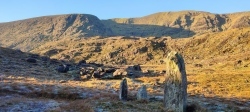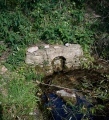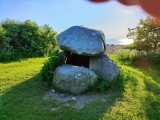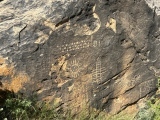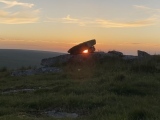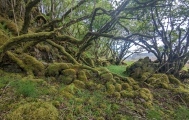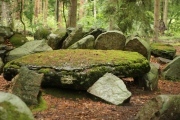Andy Burnham's Blog, page 63
June 26, 2024
Curragh More stone row
A stone row located in the townland of Curragh More, Co Kerry. The row, 2.7m long, is comprised of three stones and is orientated ESE-WNW. The tallest stone, at E, stands 1.95m high.
Published on June 26, 2024 14:24
June 25, 2024
Gorrick’s Well
This attractive well is found down from a layby on the road north of the village of Calverton. The spring flows from a well worn lion’s head and into a trough made up partly of concrete blocks. It is reached by a series of steps. Its waters were said to be healing and was used by a local Friar.
Published on June 25, 2024 06:24
June 24, 2024
Lyø Klokkesten Runddysse
Megalitgrav (Dolmen) on the island of Lyø. Klokkesten translates as The Bell Stone. With a single large capstone, the sound of which, when struck, has given the site its name.
Published on June 24, 2024 15:38
Andy B's Old Stones talk 16th July Online for the Festival of Archaeology
Free to Megalithic Portal Society / Contributory members. Join Megalithic Portal founder Andy Burnham for a lively and highly illustrated talk based around many of the themes and new discoveries from our book The Old Stones. Including:
Published on June 24, 2024 07:49
June 23, 2024
Parowan Gap Petroglphys
Parowan Gap has two features of distinction, one natural, one man-made. The pass is a classic example of a wind gap, an unusual geological landform marking where an ancient river has cut a 600-foot-deep notch through the Red Hills. Secondly, the gap is a nationally recognized extravaganza of petroglyphs - a "gallery" of Native American rock art pecked into the rock.
Published on June 23, 2024 17:08
June 22, 2024
Trevelgue Head
An outstanding headland to the north of Newquay in Cornwall with still impressive Iron Age ramparts. The site is most dramatic when a heavy sea attacks the cliffs. This site must have been of special importance in prehistoric times because it protected a harbour probably used by those trading the local tin. Indeed evidence has been found here of bronze-smelting during the Bronze Age. Look out for the round barrows in various locations on the headland.
Published on June 22, 2024 03:59
June 21, 2024
Leskernick Quoit
The solstice sunset from last night, thanks Sara!. Near to the top of Leskernick Hill is a propped stone, which is thought to be a manmade site of ancient provenance - once thought to be a sort of dolmen, or quoit in Cornwall hence its name. It consists of a deltoid rock slab propped up on the main surface of a smooth rock platform, which looks possibly natural, but all I have read suggests that it has been put there with human hands.
Published on June 21, 2024 02:48
June 19, 2024
Navajo Nat. Mon. - Betatakin
Kayenta Ancestral Puebloan Ruin in Navajo County, Arizona. The village was built around 1250 AD and was occupied for about 50 years. It had 135 rooms, many of them granaries, and one kiva. The stone buildings are sited in a south east facing "cave" shelter in the Tsegi Canyon. Many of the rooms are reduced to the lowest runs of masonry. Others are relatively intact, with wood beams and supports in place.
Published on June 19, 2024 10:02
June 18, 2024
Torr A'chlachain, Mull
This fort is an irregular oval on plan, 49m by 26m within a single wall which has been between 3m and 4.3m in thickness. Along the NE and SW sides the wall has almost vanished down the steep rocky flanks of the ridge and, where still visible, is now represented only by several outer facing-stones.
Published on June 18, 2024 13:18
Steinkiste Teufelssee Nord
This site is believed to be modern, set up in the 18th or 19th century when many ancient sites where robbed of stones for street or house building. Marks from stone cutters are all over the site. Many large rocks show drill marks or other sings from stone cutting. 10m in diameter with a cist in the middle of a circle of large stones. The capstone is 2.4m long and 1.5m wide - a flat limestone plate.
Published on June 18, 2024 13:12

